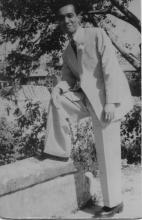07 Dec 1941, Major John Monro MC RA diary of the Battle of Hong Kong
Primary tabs
This morning when I went to the office, I found that the situation had worsened. I don’t really believe that anyone thinks that it will come to anything. We have had so many flaps and lived in a state of tension for so long that we have become blasé. We live only for the day when the rather annoying precautions that interfere with our private amusements are once more considered unnecessary. This is more serious than most. The Hong Kong Regiment have been ordered to get their ammunition onto their mainland positions.
I will here attempt to outline the plan for the defence of the colony.
((For General Maltby’s account of the defences of HK and the battle go to http://www.britain-at-war.org.uk/WW2/London_Gazette/hong_kong/index.htm))
For the past two years the intention had been merely to deny the use of the harbour to the enemy and to hold the island at all costs. It was realised that it was impossible to hold the colony in sufficient strength to enable it to be used as a Naval Base. No attempt was to be made to hold the mainland or Kowloon. A small force consisting of Bu of infantry (Punjab Regt) with some armoured cars of the H.K.V.D.C. (Hong Kong Volunteers Defence Corps) were to cover the demolition parties and fight delaying actions on the Taipo and Castle Peak roads, eventually withdrawing more or less intact to the island. A company of the Rajputs were to fight a delaying action on the Devil’s Peak Peninsula. No artillery was to be deployed on the mainland. The infantry would get such artillery support as was possible from the C.D. ((Coastal Defence)) guns (Stanley Battery could reach targets a little beyond Shatin Station) and, in the latter stages during the withdrawal from Kowloon, from the 6” Hows of the Hong Kong Regt.
On initial deployment all the guns of the Hong Kong Regt. went to prepared positions on the island. The Rajput Regt. occupied the N.E and S.E sectors, the Royal Scots occupied the S.W sector while the N.W or city sector was to be occupied by the Punjabs on withdrawal from the mainland. There was a very small general reserve, consisting, so far as I remember, of two companies, one from the Scots the other from the Rajputs. They were also responsible for internal security! The Middlesex Regt. a Machine Gun Battalion, occupied pillboxes built on the beaches all round the island. In addition there were the Coast and AA Artillery Regiments who manned positions already prepared and finally the Hong Kong volunteers, who provided the officers and men for four improvised C.D. Batteries, one section of heavy A.A., numerous light A.A. machine guns, armoured cars, various pill boxes, local defence platoons, medical and engineering units.
The arrival of the Canadians entailed great changes in this plan. In addition to the island, Devil’s Peak Peninsula was now to be held at all costs. The “inner line”, a great belt of pill boxes and wire, constructed in the time of General Bartholomew, on the northern slopes of the ring of hills encircling Kowloon, was to be held in force by three Battalions for about six weeks, whilst the island would be held against any attack from the sea by the Coast Defences in which I include the B.D Bty and the two Canadian Battallions. For artillery support on the mainland there were two four gun 3.7 How Btys in pack; one four gun How Bty with so negligible a quantity of M.T. that it was almost immobile and one four gun 6” How Bty which was in a somewhat similar state. Some 60 pdr guns of a very old mark and some ammunition was found in the ordnance depots. These were emplaced on Stonecutters Island but came under the orders of H.Q. mainland R.A.

